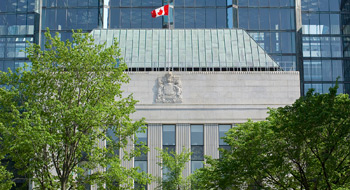
The Bank of Canada is lowering its target for the overnight rate by 0.25% to 0.75%. It was at 1% since September 2010.
This decision is in response to the recent sharp drop in oil prices, which will be negative for growth and underlying inflation in Canada, the bank says.
Inflation has remained close to the bank’s 2% target in recent quarters. Core inflation has been temporarily boosted by sector-specific factors and the pass-through effects of the lower Canadian dollar, which are offsetting disinflationary pressures from slack in the economy and competition in the retail sector. Total CPI inflation is starting to reflect the fall in oil prices.
Read: How can pension funds cope with a low interest rate environment?
Oil’s sharp decline in the past six months is expected to boost global economic growth, especially in the United States, says the bank. Persistent headwinds from deleveraging and lingering uncertainty will influence the extent to which some oil-importing countries benefit from lower prices. The Bank’s base-case projection assumes oil prices around US$60 per barrel. Prices are currently lower but the bank’s belief is that prices over the medium term are likely to be higher.
“The oil price shock is occurring against a backdrop of solid and more broadly-based growth in Canada in recent quarters,” said the bank in a statement today. “Outside the energy sector, we are beginning to see the anticipated sequence of increased foreign demand, stronger exports, improved business confidence and investment, and employment growth. However, there is considerable uncertainty about the speed with which this sequence will evolve and how it will be affected by the drop in oil prices. Business investment in the energy-producing sector will decline. Canada’s weaker terms of trade will have an adverse impact on incomes and wealth, reducing domestic demand growth.”
The bank projects real GDP growth will slow to about 1.5% and the output gap to widen in the first half of 2015. The negative impact of lower oil prices will gradually be mitigated by a stronger U.S. economy, a weaker Canadian dollar, and the Bank’s monetary policy response. The bank expects Canada’s economy to gradually strengthen in the second half of this year, with real GDP growth averaging 2.1% in 2015 and 2.4% in 2016. The economy is expected to return to full capacity around the end of 2016, a little later than was expected in October.
Read: Bond allocations: Adjusting to changing rates
Weaker oil prices will pull down the inflation profile. Total CPI inflation is projected to be temporarily below the inflation-control range during 2015, moving back up to target the following year. Underlying inflation will ease in the near term but then return gradually to 2% over the projection horizon.
The oil price shock increases both downside risks to the inflation profile and financial stability risks. The Bank’s policy action is intended to provide insurance against these risks, support the sectoral adjustment needed to strengthen investment and growth, and bring the Canadian economy back to full capacity and inflation to target within the projection horizon.
This story originally appeared on our sister site, Advisor.ca.
Also read:
